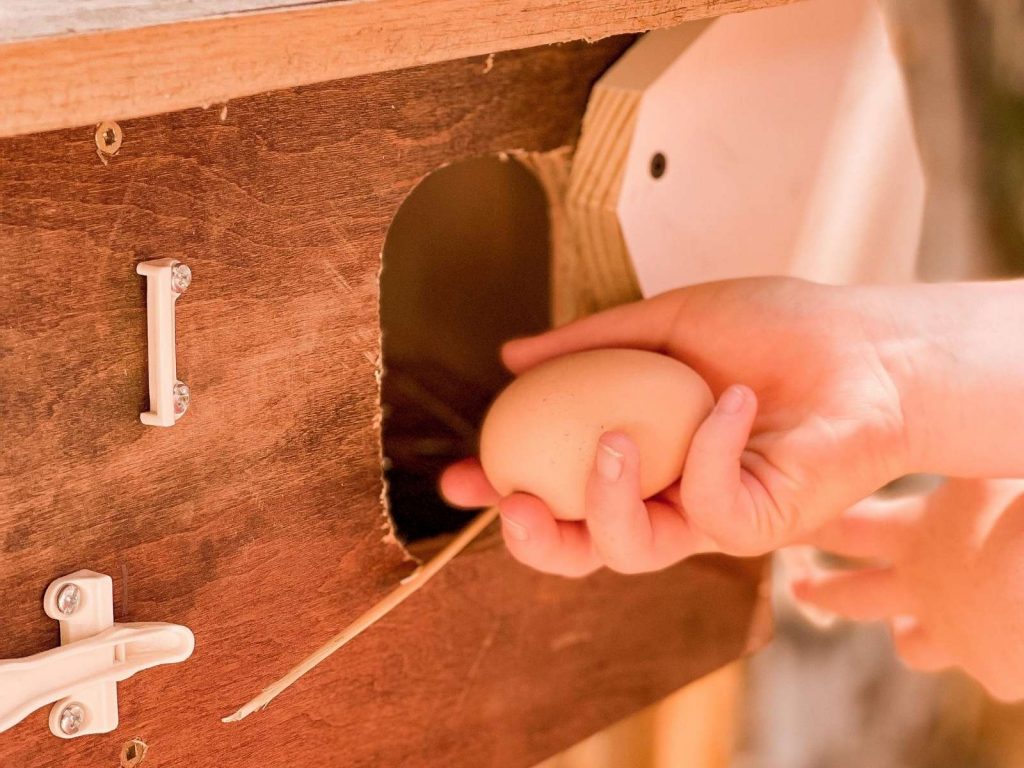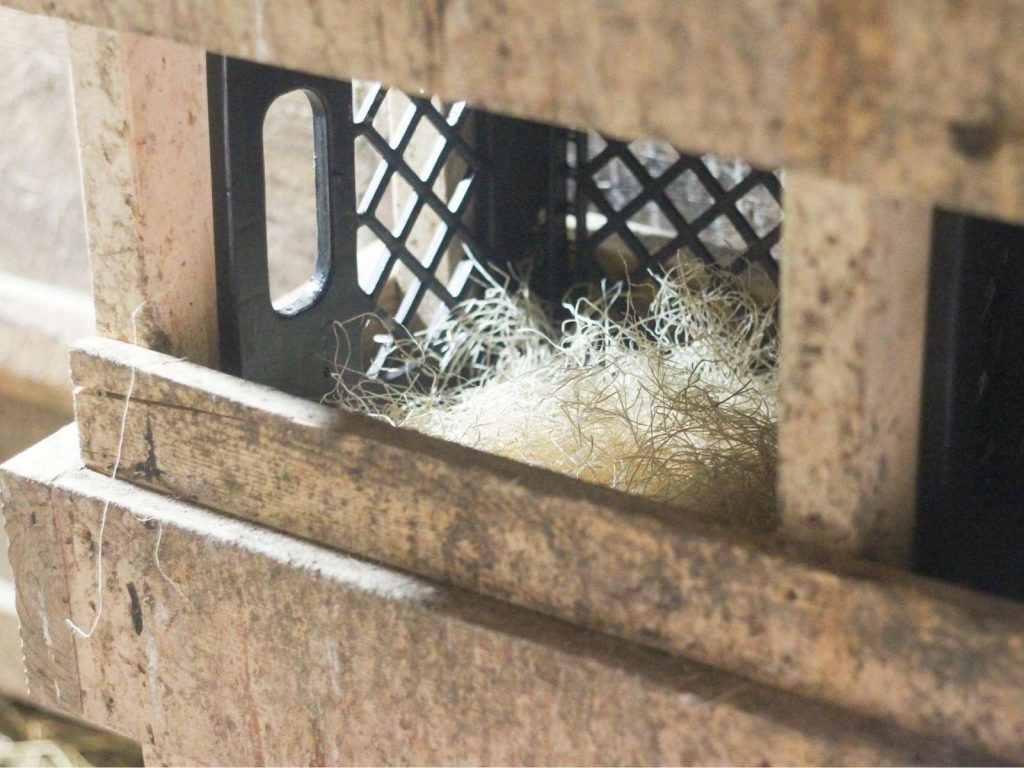How Big Does My Chicken Nesting Box Need to Be?
An important part of backyard chicken keeping is having a safe place for your hens to lay their eggs. This post helps you understand exactly how to set up your chicken nesting boxes.

Raising chickens has quickly become one of my favorite homesteading activities. They are easy to care for, provide endless entertainment and lots of eggs.
Today we’re going to tackle one of the common housing components that new chicken owners have questions about…chicken nest boxes.
- What is a nesting box?
- Nesting box sizes.
- How many nesting boxes do I need?
- Ideas for building a nesting box.
- FAQ’s
What is a nesting box?
A chicken nesting box is a safe and private place for your hens to lay eggs. Not only is it meant to be a safe place for your hens to lay, but it also keeps your hens from laying eggs all over the run or yard.

What size does a chicken nesting box need to be?
For most backyard chickens, the recommended size box is a 12″ X 12″ X 12″ cube. That’s 12 inches deep, 12 inches wide, and 12 inches high.
If you have larger breeds, like Jersey Giants, you can use box dimensions of 12 inches deep X 14 inches wide, and 12 inches high. (12″ X 14″ X 12″)
Likewise, if you only have smaller bantam chickens, you can use boxes that measure 10 inches deep X 12 inches wide X 10 inches high. (10″ X 12″ X 10″)
If you have multiple breeds of chickens in your flock, which is fairly common for backyard chicken keepers, make sure you provide enough space for the largest chicken breed you have.
**Check out this post to learn more about storing all of those fresh chicken eggs!**
Can a nesting box be too big?
Bigger is not always better for nesting boxes. Choosing the right size helps your laying hens to feel safe. A wide-open space won’t give the same safe feeling as an appropriate size box, and your hen may decide she would rather lay elsewhere.
It’s not the end of the world, but it sure does make it nice when you don’t have to search all over for eggs.
Does each chicken need its own nesting box?
No, each hen does not need a box. As a general rule, you want to provide a laying box for every 4-5 hens, but always a minimum of 2 boxes even if you only have a few hens.
Hens will share nesting boxes and there isn’t an exact science to how many you need, but there are some general guidelines most people follow.
Do I need a nesting box for my rooster?
No, you do not need to include your rooster(s) in the count for the nesting boxes. Since roosters don’t lay eggs, they don’t need to use a nesting box.
How many nesting boxes for 6 chickens:
6 hens will need a minimum of 2 nesting boxes.
How many nesting boxes for 12 chickens?
12 hens will need a minimum of 3 nesting boxes.
How many nesting boxes for 15 chickens?
15 hens will need a minimum of 3 nesting boxes.
Ideas for Good Nesting Boxes
We talked about building an extension off the side of the coop, but what else can be utilized for nesting?
Some good choices are milk crates, 5-gallon buckets, and even empty plastic cat litter boxes. These plastic containers make for easy cleaning and you may already have some lying around.
Simply lay them on their side, elevate off the ground, and place bedding in them (such as wood shavings or grass clippings). You can them mount them to the wall or build a frame for them. Place them with the opening placing out so the hens can jump in.

Where should nesting box be?
Ideally, the nesting box location is going to be private, dim, and elevated. These components can be achieved in a variety of ways and ultimately will depend on your coop and run set up.
If you are building your own chicken coop, you may opt to build to a wooden nesting boxes off of one side, with a lid that opens for you. This is the most common layout of prefabricated coops, but you can duplicate it with a DIY build.
We opted to go with this layout for our chickens, and it has worked great. (see a video of our coop and run here).
If you have a large coop that you can walk in, another option is to mount the nesting boxes on a wall or set them up on a small table or other surface.
It is important that you also think about egg collection and cleaning out the pine shavings. You want to make sure the nesting box is easily accessible by you, or whoever is gathering eggs, since you will be doing this daily. Also, trying to clean out a poorly placed nesting box can be a pain, so make sure you can get in there to scoop the bedding material out.
Should laying boxes be elevated?
Your laying boxes should be elevated 1 1/2 to 2 feet off of the ground.
Just ensure that the laying boxes are not mounted higher than the roosting bars you provide. If they are the highest surface, your chickens will start to roost on the boxes – and you will end up with really dirty boxes and eggs.
Will free range chickens use chicken nesting boxes?
Yes! We free range our chickens and they still lay in their boxes. We “box trained them” before starting to free-range and have had no issues with random egg laying. Just make sure you keep easy access to the boxes all day, and they will come back.
Why won’t my hen leave the nesting box?
If your hen is spending day after day in the nesting box and is showing signs of irritability, it is a good chance she has gone broody. This means that she is wanting to hatch eggs – hers and even others she has stolen.
It is up to you if you want to break the brood or not. Here is an article that you may find helpful if you have a broody hen.
Why won’t my chickens use the nesting box?
A few reasons your hen may not be using the nesting box are:
- too large or too small
- not private enough
- too many hens, not enough boxes
If you don’t think the issue is size or privacy, your hen may just need a little coaching. The best way to do this is by placing fake eggs or golf balls in the laying boxes to show her that is where the eggs go. Believe it or not, chickens catch on fairly quickly with this method.
If you are planning to free range your chickens, you may need to keep them in the run/coop until they’ve caught on to where the eggs go. Once they catch on, they should run back to the boxes each day to lay.
Should I put bedding in the nesting box?
Yes, bedding is an important part of setting up your nesting box. You will want to use a bedding material that provides some cushion under the eggs to prevent cracking. Some of the most common bedding materials used are:
- Pine or Cedar Shavings
- Recycled Shredded Paper
- Sand
- Grass Clippings
Whichever option you choose, you will want to regularly change it out. Dirty bedding means dirty eggs, and no one enjoys those.
Why are my chickens pooping in the nesting box?
Typically, your chickens are pooping in the nesting box because they are sleeping in them. A sleeping chicken is a pooping chicken.
If you’ve found that your chickens are sleeping in the boxes, you may need to look at your roost set up.
Is your roost low enough for the chickens to get on?
If the roost is over 2 foot high, your chickens may not be able to reach it.
Is your roost lower than your nesting boxes?
Chickens search for the highest spot to roost. If that’s the nesting boxes, that may be why they are nesting there. Try lowering the boxes or raising the roost a little.
Is there enough space for all the birds to fit?
In general, your chickens will need about 12 inches each, both vertically and horizontally, on the roost.
Are your chickens old enough to roost?
It may also be that your hens are still too young and have not yet realized that sleeping on a roost is safer. If that’s the case, just give them a little time and they should start roosting soon enough. Usually by the 12-week mark, most chicks have caught on to roosting.
More Homesteading Posts:
The Best Animals for a Small Homestead or Farm – Humbly Rooted Home
How Much Does It Cost to Raise Chickens for Meat [2022] – Homesteading
How to DIY a Cheap Brooder Box for Chicks – Humbly Rooted Home
